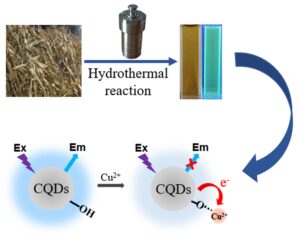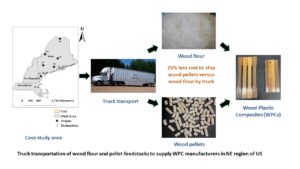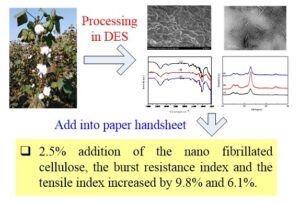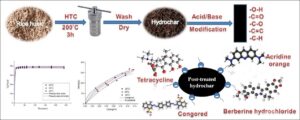Volume 17 Issue 1
Latest articles
- Researchpp 592-603Chang, L., Liu, Y., Zhang, W., Xu, G., Wang, L., and Yuan, W. (2022). "Antifungal activity and chemical composition of neem seed extract (Azadirachta indica A.)," BioResources 17(1), 592-603.AbstractArticlePDF
The antifungal activities and chemical composition of neem seed extract (Azadirachta indica) were investigated. An agar diffusion assay showed that neem seed extract (optimum concentration: 10%) inhibited the growth of Trametes versicolor and Gloeophyllum trabeum. The minimum inhibitory concentration and minimum fungicidal concentration were 2% and 4%, respectively, against the two fungal species. Scanning electron microscopy revealed severe morphological damage to fungal hyphae, including reduction of spores and hyphal shriveling. Fourier transform infrared spectroscopy and gas chromatography-mass spectrometry analyses identified 17 compounds that represented 80.3% of the total extract, including astaxanthin (34.3%), cinobufagin (16.9%), anodendro-side A (6.65%), 16-acetoxy-4,8,14-trimethyl-3,11-dioxo-, methyl ester (5.09%). Furthermore, T. versicolor-infected wood and G. trabeum-infected wood treated with 10% neem seed extract displayed mass decreases of 11.4 ± 5.8% and 25.8 ± 7.5%, respectively, compared with distilled water treatment (21.6 ± 4.2% and 46.9 ± 4.3%, respectively). These findings suggest the potential use of neem seed extract for antifungal wood protection.
- Researchpp 604-615Yang, J., Guo, Z., and Yue, X. (2022). "Preparation of carbon quantum dots from corn straw and their application in Cu2+ detection," BioResources 17(1), 604-615.AbstractArticlePDF

Water-soluble carbon quantum dots were hydrothermally produced using corn straw as the starting material and nitric acid solution as solvent, then they were introduced as fluorescent probes for the detection of Cu2+. High-resolution transmission electron microscopy and X-ray diffraction showed that the carbon quantum dots were spherical amorphous particles with a diameter of 5 nm. The surface functional groups of carbon quantum dots were observed via Fourier transform infrared spectrometry and X-ray photoelectron spectroscopy. A new approach for Cu2+ detection was designed using carbon quantum dots based on fluorescence quenching. Linear relationships between the fluorescence variation and the Cu2+ level (1 mg·L-1 to 20 mg·L-1 and 20 mg·L-1 to 500 mg·L-1) were obtained, with coefficients of determination of 0.9960 and 0.9923, respectively. The Cu2+ detection limit was 4.26 mg·L-1. The probable quenching principle between Cu2+ and the carbon quantum dots was attributed to charge transfer.
- Researchpp 616-633Yucel, G. (2022). "Seed propagation, adaptation to cultivation conditions, determination of ornamental plant properties, and ex situ conservation of the endemic species Centaurea hermannii F. Hermann," BioResources, 17(1), 616-633.AbstractArticlePDF
This study focused on seed propagation and ex situ conservation of the endemic species Centaurea hermannii F. Hermann. Plant properties such as vegetation cycle, adaptation to the cultivation environment, morphological characteristics of the plants and seeds, and esthetic properties as an ornamental variety were investigated. The percentage of viability of the seeds, as well as the effects of different seed germination methods when applied to the germination speed, were also explored. C. hermannii specimens planted in soil adapted quickly under field conditions and flowered over a period of two months, with a bright-orange color and glossy blossoms. In addition, the plants displayed all the type-specific botanical and esthetic properties, as well as provided value as an ornamental plant. An ex situ conservation area was created with the plants collected. To determine the best germination conditions for C. hermannii seeds, various methods were explored. Among these, a combination of 200 ppm of GA3 treatment during a three-month storage period at 4 °C, followed by cold-wet stratification at 4 °C for three months, produced the best results in terms of mean percentage germination (70.5 %) and mean germination speed (3 days).
- Researchpp 634-651Pokhrel, G., Kizha, A. R., and Gardner, D. J. (2022). "Transportation cost analysis on alternative wood feedstocks for manufacturing wood-plastic composites," BioResources 17(1), 634-651.AbstractArticlePDF

This study evaluated and analyzed transportation costs for manufacturing wood-plastic composites (WPCs) using wood flour and wood pellet feedstocks. The study area ranged from Maine (ME) to Massachusetts (MA) in the Northeast region of the United States (US). Wood mills in ME were the raw material providers, and the WPC manufacturers in ME and MA were the destinations. The methodologies included the Origin-Destination (OD) cost matrix feature in ArcGIS to find least-cost pathways from each facility to each destination; baseline scenarios based on trucking costs, travel distances, and wood feedstocks; and sensitivity analyses to study the effects of fluctuating input variables (travel distance, shipment weight, and shipping costs over distance) to the shipping costs by weight. Accordingly, the best and worst-case scenarios were identified. The OD-cost matrix showed that shipping feedstocks from southern ME required shorter travel distances than from other regions because of proximity. Transporting wood pellets in a truck would reduce shipping costs by at least 25% compared to wood flour. The shipping costs by weight were inversely related to the shipment weight. The shipment weight of wood pellets was higher than flour in a truck trailer with fixed volume. It is foreseen that the transportation of wood pellets as opposed to wood flour would be economical.
- Researchpp 652-672Reinprecht, L., and Repák, M. (2022). "Beech wood thermally modified in the melt of polyethylene glycol," BioResources 17(1), 652-672.AbstractArticlePDF
Various techniques of wood thermal modification in air, liquids, or melts at temperatures above 160 °C improve its resistance to biological damage and water. In this experiment, the European beech (Fagus sylvatica L.) wood was held for 1 to 4 hours in the melt of polyethylene glycol 6000 (PEG 6000) and during a given time either heated at 100 °C or thermally modified at 190 or 210 °C. Its decay resistance improved – maximally at using the more intense modification mode 210 °C/4h – to Poria placenta by 60.3% and to Trametes versicolor by 62.8%. The soaking and volume swelling in water of the PEG-thermally treated beech wood usually was significantly reduced, after 336 h maximally by 60% and 34.6%, respectively. The presence of PEG during the thermal modification processes caused darkening of beech wood – a decoratively interesting and more pronounced effect than what occurs in traditional air-thermal modifications – at which the Eab* was also great from 13.1 to 52.6. However, since the mechanical properties of the PEG-thermally modified beech wood worsened – impact bending strength maximally by 34% and Brinell hardness maximally by 43.3% – its application for structural elements would be limited.
- Researchpp 673-681Shi, H., Guo, J., Yan, X., Cui, G., Tan, Z., Zhu, X., Zhou, J., He, S., Wang, T., and Li, X. (2022). "Characterization of a xyloglucananse in biodegradation of woody plant xyloglucan from Caldicellulosiruptor kronotskyensis," BioResources 17(1), 673-681.AbstractArticlePDF
The 2,835-bp open reading frame of ckxgl74A (Locus_tag CALKRO_RS04315) with a natural carbohydrate module (CBM3b) from thermophilic anaerobic microorganism Caldicellulosiruptor kronotskyensis encodes a calculated 104-kDa of GH74 xyloglucanase Ckxgl74A. The purified recombinant Ckxgl74A expressed in Escherichia coli BL21 (DE3) revealed its optimal pH of 4.5 and temperature of 80 °C. The Ckxgl74A was stable over a temperature no more than 70 °C and a pH range of 4.5 to 5.0. Kinetic experiments with xyloglucan as a substrate gave a Km of 2.29 ± 0.04 mg mL-1, Vmax of 22.98 ± 0.02 mol mg-1 min-1, and kcat of 66.98 ± 0.01 s-1. Its activity could be activated by Ca2+ approximately two folds, while being significantly inhibited by Cu2+. These results showed that Ckxgl74A could be utilized in acid condition and possessed a good thermostability.
- Researchpp 682-698Pan, S., Wang, K., Chen, J., and Zhang, Y. (2022). "Larch wood defect definition and microscopic inversion analysis using the ELM near-infrared spectrum optimization along with WOA–SVM," BioResources 17(1), 682-698.AbstractArticlePDF
Near-infrared spectroscopy is a mature non-destructive testing technique that can be applied effectively to identify and distinguish the structural characteristics of wood from a microscopic perspective. To accurately describe the morphology of wood panels on multiple scales and uncover the mechanisms determining the mechanical properties of wood, the present study was initiated by first defining four regions—the knot, fiber deviation, transition, and clear wood regions. On the surface of solid wood panels, and then a method was presented for inversing the microscopic morphology of larch wood panels based on near-infrared spectral feature extraction and modeling analysis. The experiments revealed that the combinatorial optimization conducted after the extreme learning machine feature band optimization can help effectively extract appropriate near-infrared feature wavelengths, reduce model dimension, and improve model applicability and accuracy. Therefore, the near-infrared models established based on the combination of the whale optimization algorithm and a support vector machine could accurately define and distinguish the four regions on the wood surfaces. Moreover, it was confirmed that the application of NIR spectral features along with the ELM–WOA–SVM algorithm can help optimize the traditional linear description that models the defect morphology as a cone to an accurate nonlinear description and to perform highly accurate nonlinear inversion of panel morphology.
- Researchpp 699-713Dou, Y., Bao, A., Sun, D., and Niu, Z. (2022). "Rapid preparation of a composite insulating block comprising waste expanded polystyrene (EPS) foam and rice straw," BioResources 17(1), 699-713.AbstractArticlePDF

Due to the world’s decreasing energy supply, reducing the energy consumption of building envelopes has become an urgent issue with economic benefits. Rice straw is a generally available agricultural residue. The purpose of this study was to estimate the effects of rapid pretreatment methods and slaked lime on the molding of rice straw insulation blocks and to evaluate the effectiveness of integrating expanded polystyrene (EPS) particle waste with rice straw as building materials to reduce the energy loss in buildings. The pretreatment time was shortened from 6 h to 3 h by mechanical stirring combined with lye soaking. The molding of the insulation block could be improved by the hardening of slaked lime through contrast experiments and electron microscope scanning. Moreover, the influences of the mass ratio of slaked lime to rice straw (RSR) and the dosage of the EPS particles (ωEPS) on the dry apparent density and the thermal conductivity of the insulation blocks were studied. The results showed that the slaked lime would increase the dry apparent density and weight of the insulation block, but the EPS can effectively reduce this negative effect and keep the thermal conductivity of the insulation block below 0.049 W·m-1·K-1. Ultimately, the rapid pretreatment technology was determined to include lye soaking for 3 h and mechanical stirring for 5 min. The material matching ratio scheme was determined to have a ωEPS value of less than 3% and an RSR value equal to 1/7.5.
- Researchpp 714-724Deng, X., Wan, L., Sun, H., Li, C., Liu, F., Yan, X., Liu, K., and Ye, S. (2022). "Preparation of nanocellulose from cotton fibers in deep eutectic solvent (DES) and its application in paper," BioResources 17(1), 714-724.AbstractArticlePDF

The bond strength and stability of the intermolecular network structure of cellulose play a decisive role in the tensile strength and rupture resistance of paper. In this work, the surface morphology, the chemical composition, and the crystal structure of nanocellulose prepared from cotton fibers were characterized by scanning electron microscopy (SEM) analysis, X-ray diffraction (XRD), and Fourier transform infrared spectroscopy (FTIR) to prepare cotton fiber nanocellulose by green solvent deep-eutectic solvent pretreatment combined with the ultrasonic method. Nanocellulose of different morphology and structure was used as a papermaking additive to explore its effect on the strength performance of the paper. The results show that the burst resistance index of the paper handsheets could be increased by 6.1% and 9.8%. The burst resistance index improved as the added amount of the NFC was increased.
- Researchpp 725-749Hagos, F. M., Qian, H., Di, J., Shan, S., Yang, R., Li, Y., and Gai, X. (2022). "Rice husk hydrochars prepared with different post-treatment methods for the adsorption of dyes and antibiotics," BioResources 17(1), 725-749.AbstractArticlePDF

Hydrochars produced via hydrothermal carbonization of rice husk were post-treated using three different acids and two bases. The post-treated hydrochars were characterized using different methods and evaluated for adsorption of dyes and antibiotics from aqueous solutions. The post-treated hydrochars had carbon and oxygen contents in the range of 37.4% to 44.7% and 29.9% to 38.6%, respectively, and their surfaces were rich in oxygen-containing functional groups and negative surface charges. Post-treatment remarkably influenced the physico-chemical properties of the hydrochars’ surfaces. All post-treated hydrochars could adsorb the model organics from aqueous solutions with the highest adsorption amount of 327, 353, 336, and 309 mg/g for Congo red, berberine hydrochloride, tetracycline, and acridine orange, respectively, at 0.3 mg/mL and 25 °C. The combined effects of functional groups, surface area, and negative surface charge of the hydrochars could assist in the adsorption of organics. The Langmuir-isotherm model provided a good fit for the adsorption of acridine orange, tetracycline, and berberine hydrochloride on the selected hydrochars, while the adsorption of Congo red generated linear isotherms indicating a partition-involved mechanism. The adsorption of the organics onto the hydrochars is a spontaneous and mainly physical adsorption process with a quite fast adsorption rate.
